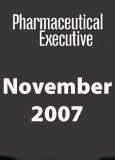More Confidence—or Slower Development?
Pharmaceutical Executive
FDAAA aims to restore public trust in drug safety regulation but may curb investment in R&D
Congress managed to approve the Food and Drug Administration Amendments Act (aka FD-triple-A) in time to reauthorize the Prescription Drug User Fee program (PDUFA IV) before that expired Sept. 30, 2007. But the last-minute rush forced the legislators to compromise on many specific issues that could have long-term ramifications for agency operations and company R&D decisions.

Jill Wechsler
Curbs on drug advertising, stiffer label warnings, limited distribution programs, and broad research disclosure may all combine to limit prescribing. This "makes marginal drugs even more risky" for industry R&D programs, observes attorney John Kamp. Safety or efficacy questions about a product in Phase II, he predicts, will make a company hesitant about going forward.
Conversely, all the new regulatory tools now available to FDA could boost the agency's confidence about being able to tackle safety issues that crop up after a drug comes to market. Such enhanced authority could make the agency more willing to bring a drug to market and evaluate the need for added safeguards later.
While it may take some time to assess the impact of this lengthy and complex legislation, FDAAA won't be the last word from Congress on protecting the public from dangerous medicines. The legislators are likely to seek a legal pathway for follow-on biologics next year, and that could provide a vehicle for imposing a full moratorium on DTC advertising or stiffer penalties for violating new requirements.
Wins and Losses
Overall, manufacturers applauded the enactment of FDAAA. The bill retained incentives for industry to conduct additional pediatric studies, curbed the scope of new penalties for fraud and noncompliance, and kept the door open for DTC advertising of new drugs. At the same time, FDA gained more authority to control drug marketing and labeling, require postapproval studies, establish active surveillance systems, and make clinical trials more transparent.
Implementation will be an arduous task. The legislation contains at least 200 specific provisions, noted FDA Commissioner Andrew von Eschenbach. The job of sorting through all the new requirements now falls to FDA Deputy Commissioner Janet Woodcock. She recently took over as acting director of the Center for Drug Evaluation and Research (CDER) following the departure of Steven Galson to be Department of Health and Human Services acting surgeon general. Woodcock implemented the user fee program as CDER director for 10 years and knows the ropes. But she may not get enough new resources to do the job smoothly—or to modernize drug development. The new Reagan-Udall Foundation established by FDAAA to support FDA's Critical Path Initiative is authorized to receive a maximum $1.3 million, and that funding has to come from FDA's own tight budget.
Some last-minute changes also may create serious legal problems for pharma. The final bill contains very murky language on whether FDA regulations preempt state drug-labeling laws. This thorny issue has pitted federal regulators against states eager to establish more-stringent disclosure policies for medical products. The vagueness of the FDAAA provision is expected to lead to a major legal battle, which may very well end up before the Supreme Court.
Enhancing Safety
There was uncertainty over what requirements would fall under the new Risk Evaluation and Mitigation Strategy (REMS) program and what new mandates would apply more broadly. In the end, FDAAA authorizes FDA to impose labeling changes, additional postmarket studies, and advertising curbs on all drugs—not just for those products that warrant a REMS. Conversely, the legislation stops short of requiring a REMS for all new drugs, as originally proposed, and leaves it to FDA to decide whether a new product warrants added safeguards to minimize risks.
FDAAA also expands current clinical trial registration requirements to cover all trials for drugs, biologics, and medical devices beyond Phase I intended to support market applications. This trial registration system will link to an extensive clinical trial results database that eventually will make available to the public information on the outcomes and safety issues generated by the studies.
Similarly, the legislation authorizes FDA to require pharmaceutical companies to submit planned TV ads for agency pre-review. And all TV and radio commercials for drugs will have to include a "major statement" of the product's side effects and contraindications. This approach is more palatable for marketers than banning consumer advertising for the first year a drug is on the market. The Institute of Medicine (IOM) panel that examined FDA drug safety policies backed such a moratorium, as did many members of Congress. But the likelihood that even a one-year ad ban would violate First Amendment rights to free speech persuaded the lawmakers to adopt the pre-review option instead.
Balancing Opinions
Giving FDA authority to require all drugs to conduct postapproval studies, to control labeling changes, and to require risk disclosure in DTC advertising should reduce the need for broad use of REMS, says attorney Scott Lassman of WilmerHale. Moreover, manufacturers that fail to follow the new rules or that air false and misleading ads would be subject to civil monetary penalties, an added enforcement tool designed to boost public confidence in FDA's ability to control drug marketing and distribution practices.
But some members of Congress believe that FDA has been slow to respond to emerging drug safety concerns because agency staffers responsible for postapproval safety evaluation have been ignored and marginalized by those offices responsible for evaluating and approving new drugs for market. Earlier this year, there was a push on Capitol Hill to establish a separate drug safety office at FDA to give postapproval risk-assessment activities more clout. But both industry and agency officials opposed the idea as likely to disrupt a balanced approach for weighing drug risks and benefits.
Instead, the legislation states that important decisions related to drug safety, such as mandating postapproval studies or a REMS, should be evaluated by both the Office of New Drugs (OND) and postapproval safety experts in the Office of Surveillance and Epidemiology (OSE). FDAAA calls for FDA to enhance communication between pre- and postmarket review staff and to report to Congress in two years how well the agency is addressing safety issues identified by OSE.
At the same time, FDA will expand OSE operations with the help of additional user-fee revenues earmarked for postmarket surveillance of any drug on the market—not just newly approved ones. OSE gains $30 million in fee revenues to contract with data banks and health plans for access to additional information on drug adverse events. The agency envisions a "transformation of the drug safety program" by tapping into population-based epidemiological and observational data to carry out targeted postmarketing surveillance, to look at class effects of drugs, and to better detect safety signals. The final bill also boosts user fees by an additional $225 million over five years, starting with $25 million more for fiscal year 2008, to support the extra work involved in designing and overseeing the REMS program, monitoring labeling changes, and establishing the enhanced clinical trials registry and results database.
By providing more resources for postmarket oversight, FDAAA may help elevate OSE's status. But the still-wide gulf between the two operations was apparent at the joint meeting in July of FDA advisory committees for Endocrinologic & Metabolic Drugs and for Drug Safety & Risk Management. The purpose was to evaluate concerns about increased risk of heart attacks for patients taking GlaxoSmithKline's diabetes treatment Avandia (rosiglitazone) flagged by several postmarketing studies.
At this high-visibility session, OND staffers disagreed with their counterparts from OSE about removing Avandia from the market. The safety experts said it would be better to pull a potentially safe drug from the market than to permit patient access to an unsafe one, especially if alternative treatments are available. The advisory panels agreed that Avandia has serious adverse-event problems, but, in the end, voted to keep the drug on the market with added safety warnings, as recommended by OND and Glaxo. However, the contradictory messages from these FDA experts added to the perception that the agency does not have a solid grasp on how to handle difficult drug safety decisions.
Many pharma executives agree with Novartis CEO Dan Vasella that FDA has become overly cautious in assessing new medicines in the wake of all the highly publicized drug safety controversies. Vasella may be particularly upset that the European Medicines Agency recently approved Novartis' diabetes drug Galvus (vildagliptin), while FDA has requested additional clinical trials that will take several years to complete. FDA has put many drug applications on hold while it weighs the import of risk signals, but some of those test products may never reach patients as a result.
Jill Wechsler is Pharmaceutical Executive's Washington correspondent. She can be reached at jwechsler@advanstar.com

FDA Grants Priority Review to Regeneron’s Eylea for Macular Edema Following Retinal Vein Occlusion
April 18th 2025Regulatory action was based on data from the Phase III QUASAR trial, which demonstrated that Eylea HD dosed every eight weeks achieved non-inferior visual acuity outcomes compared to Eylea in patients with macular edema following retinal vein occlusion.
Addressing Disparities in Psoriasis Trials: Takeda's Strategies for Inclusivity in Clinical Research
April 14th 2025LaShell Robinson, Head of Global Feasibility and Trial Equity at Takeda, speaks about the company's strategies to engage patients in underrepresented populations in its phase III psoriasis trials.
New Insights Into T Cell Exhaustion and Inflammation in Long COVID
April 17th 2025Nigel McCracken, chief operating officer, Virax Biolabs, discusses new findings that reveal altered cytokine activity and evidence of T cell exhaustion in long COVID patients, providing deeper insight into post-infection immune disruption.
Key Findings of the NIAGARA and HIMALAYA Trials
November 8th 2024In this episode of the Pharmaceutical Executive podcast, Shubh Goel, head of immuno-oncology, gastrointestinal tumors, US oncology business unit, AstraZeneca, discusses the findings of the NIAGARA trial in bladder cancer and the significance of the five-year overall survival data from the HIMALAYA trial, particularly the long-term efficacy of the STRIDE regimen for unresectable liver cancer.
Amgen’s Imdelltra Demonstrates Significant Overall Survival Improvement in Small Cell Lung Cancer
April 16th 2025In the Phase III DeLLphi-304 trial, patients with small cell lung cancer administered Imdelltra achieved a statistically significant and clinically meaningful improvement in overall survival compared to standard-of-care chemotherapy.